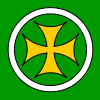Irish crosses
Roman Britain is understood to have introduced Christianity to Ireland by the 5th century. The Church flourished with the help of great saints such as Patrick, Brighid and Columba, and of course with the devout faith of the Irish people.
The Troubles (c. 1960 onwards) in Ireland no doubt encouraged people to attend church and show their political solidarity. But for the current generation, there's less stigma in not going to Mass, church attendance has declined and secularization has spread.
Disillusionment with the Church has increased with intolerance of gays and women priests, and of course the crippling sex abuse scandals which have sapped Church funds to pay the multi-billion-Euro costs. And yet we see the symbol of the Cross on these civic coats of arms, many of which are recent designs.
This is despite the worldwide trend to separate religion from State, and is testimony to Christianity being so deeply ingrained into Irish culture.
Here are the main emblems.
Armagh
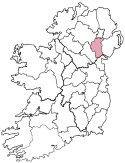
The County Armagh flag is rather unimaginative, having the left half plain orange and the right half plain white. But the City of Armagh has a wonderful coat of arms, which includes a fitched crossed crosslet in the sinister. The patriarchal form is perfectly suitable for a city that is the seat of the Church Primates of All Ireland, for both the Roman Catholic Church and the Church of Ireland, and consequently the ecclesiastical capital of Ireland.
Church of Ireland

This cross, designed by the Church of Ireland, was copyrighted in 2004. The synod will normally grant permission for use of its emblem within the Church itself, and by "fair use" (such as on this page), but may not be used for other purposes.
The Church's emblem is nearly always coloured blue; the colour may change if, for example, the background happens to be a similar colour.
The design was influenced by the style of the Celtic Cross. The Celtic Cross itself one of several 'Christian related symbols' of Ireland, along with the harp, various flags, and the shamrock. Any of these symbols could have been chosen by the Church:
(more...)
Donegal
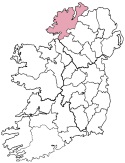
The County Donegal coat of arms features a red crossed crosslet, which, like many coats of arms, is fitched like a sword. The town of Donegal coat of arms has a red Latin Cross in its shield, with a hand grasping the shaft. The county and town symbols are sometimes seen merged so that the hand is grasping the blade of the sword. Generally not a good idea.
The Life and Acts of Saint Patrick, by Jocelyn of Furness (c. 1185 AD), tells how St. Patrick used his crozier to strike the shield of Prince Conall, imprinting upon it a cross symbol. This signalled victory in battle, as long as the prince and his ilk followed that sign.
Fingal
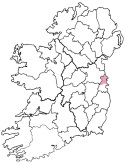
The dexter chief of the Fingal coat of arms features a St. Brigid's Cross, traditionally made from straw.
Fingal, north of Dublin, is one of the main corn-growing regions of Ireland and St. Brigid was from the neighbouring Kildare to the southwest.
Kerry
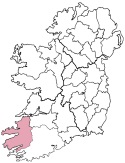
The County Kerry coat of arms features two cross crosslets, which, like many coats of arms, are fitchée-like swords. These two crosses represent the monasteries of Ardfert and Aghadoe
Ardfert is formerly a bishop's seat and the home of St. Brendan's Ardfert Cathedral. Saint Brendan the Navigator founded a monastery there in the 6th century before setting sail, but the monastery and indeed the whole town, were destroyed by fire in 1089, and again in 1151. (Brendan's boat is depicted in the lower part of the coat of arms.)
Aghadoe is possibly also formerly a bishop's seat before joining with the Bishopric of Ardfert and the monastery is believed to have been founded by St. Finian in the 6th or 7th century.
Kildare
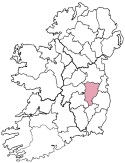
The two upward-pointing swords on the red saltire of the Kildare coat of arms are borrowed from the powerful Fitzgerald family, after the county was incorporated into the English-controlled Pale. John FitzGerald, 4th Lord of Offaly and 1st Earl of Kildare (1250–1316), was rewarded for serving the English King Edward Longshanks in Scotland, where the saltire is known as the St. Andrew's Cross. The red saltire later became known in Ireland as the St. Patrick's Cross.
The aristocratic history of this symbol contrasts sharply with the humble St. Brigid's Cross at the top of the shield.
Mayo
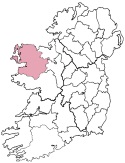
The County Mayo coat of arms features four crosses in the escutcheon's chief.
The first cross in the middle chief is the double-barred Patriarchal Cross, representing the Catholic Archdiocese of Tuam.
The three Latin Crosses beneath represent the county's three dioceses; of Achonry, of Killala, and of Galway, Kilmacduagh & Kilfenora.
Meath
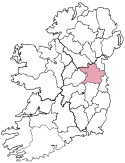
The County Meath coat of arms features a Celtic Cross in the sinister.
Curiously only a few counties in Ireland, such as County Meath, use in its coat of arms the Celtic Cross, which must rank as the most Irish of all crosses.
Offaly
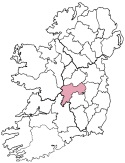
The dexter chief of the Offaly coat of arms features a patée cross with concave arms, known as the Maltese Cross.
There has been an attempt to "localize" it as a nice variation of the Celtic Cross by adding the white circle.
Roscommon
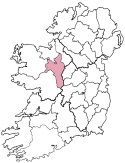
The large Maltese Cross in middle of the Roscommon coat of arms roughly matches the style of the Cross of Cong.
The early-20th-century Sacred Heart Catholic church in Roscommon, houses a replica of the Cross of Cong, a 30-inch tall processional cross made in Fuerty, Roscommon, in the years 1120–1127 for Tairrdelbach Ua Conchobair (d. 1156), King of Connacht and High King of Ireland. He donated it to the Cathedral in Tuam, County Galway and later it was moved to the Augustinian Cong Abbey, County Mayo, from which it takes its name.
It is made from oak and sheathed in various materials, including gold, silver, niello, copper, bronze, brass, enamel, and coloured glass. In the centre is a polished rock crystal which, from 1123, housed a relic sent from Rome. The relic is long gone but the inscription on the side of the cross is still clear. From the ancient Irish it translates roughly as "In this cross is preserved [or conserved] the cross on which the Founder of the world suffered." i.e., part of the True Cross.
The original 12th century Cross of Cong is on display at the National Museum of Ireland in Dublin.
Sligo
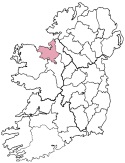
The word Sligo (Sligeach) means escallop shell; hence its presence in the coat of arms for County Sligo. There is also Celtic Cross in the dexter chief, along with a rose on an open Bible.
Curiously only a few counties in Ireland, such as County Sligo, use in its coat of arms the Celtic Cross, which must rank as the most Irish of all crosses.
Ulster

The Ulster Flag features a red St. George Cross, as used on the English flag. This became the official coat of arms of Ulster in 1972, when the Government and Parliament of Northern Ireland were abolished by the Parliament of the United Kingdom under the Northern Ireland Constitution Act 1973. It replaced the Ulster Banner, which is still used by loyalists, who call it the Red Hand Flag.
St. Patrick

No page on Irish crosses could be complete without mentioning the cross of Saint Patrick, even though he was Scottish!
Read more about St. Patrick, and why the red saltire was named after him.
Chapter 38 includes: "et mox cum baculo suo, qui baculus Jesu dicebatur Crucis signum ejus scuto impressit, asserens neminem de stirpe ejus in bello vincendum qui signum illud"
Constantine the Great saw a Chi Rho image of a cross in the sky, which he took as a sign of victory in the coming battle.
Pale: a district in eastern Ireland included in the Angevin Empire of King Henry II and his successors.
















